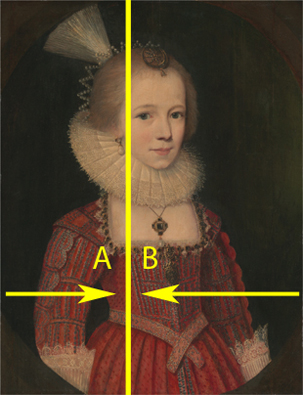
From a report by dendrochronologist Ian Tyers, “The Tree-Ring Analysis of Twenty-Three Panel Paintings from the Yale Center for British Art, New Haven,” November 2011:
This panel is ca. 652 mm high, ca. 508 mm wide, and had been thinned and cradled. The panel is probably constructed from two vertical oak boards, labeled for the purposes of this report A & B from the left.The surviving parts of the original boards are thin, and fairly badly cracked so it is possible there is a further joint to the right edge of the panel. The boards both contained sufficient rings for analysis, but the thinning and cradling made it difficult to recover the ring sequences. No sapwood was present on the edges of the boards. The absence of sapwood means that a terminus post quem [limit after which] date can be applied to the panel. [Sapwood is the newly formed outer layer of wood found on the inner side of the bark of a tree.]…
Short partial sequences were measured from the outermost part of the lower edges of both boards. These were found to match each other strongly, despite their short lengths, and are probably derived from a single tree. The composite constructed from them was found to match against eastern Baltic reference data. The date of the last measured ring was 1594. Adding the appropriate minimum expected number of sapwood rings suggests that the boards were felled after 1602.